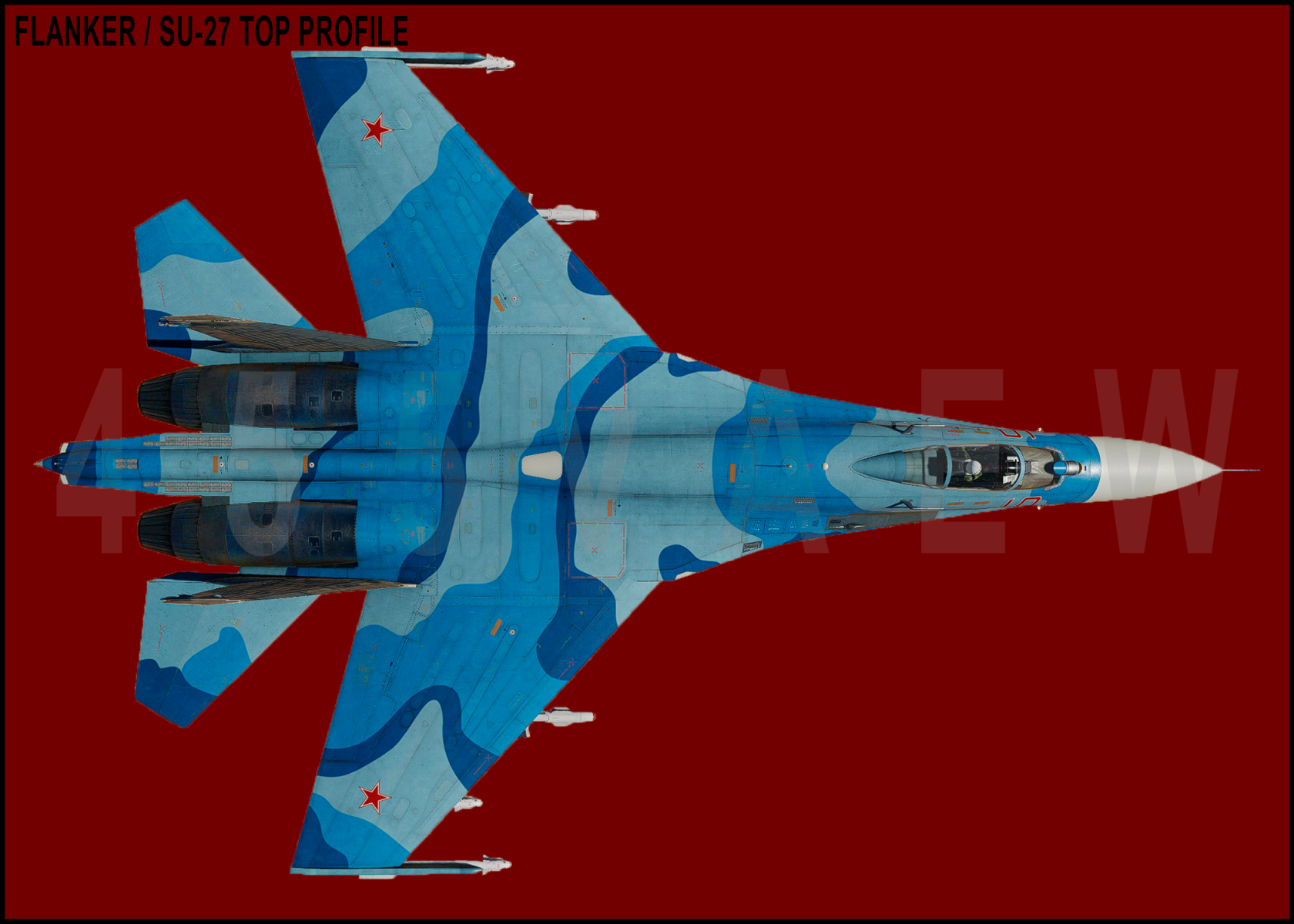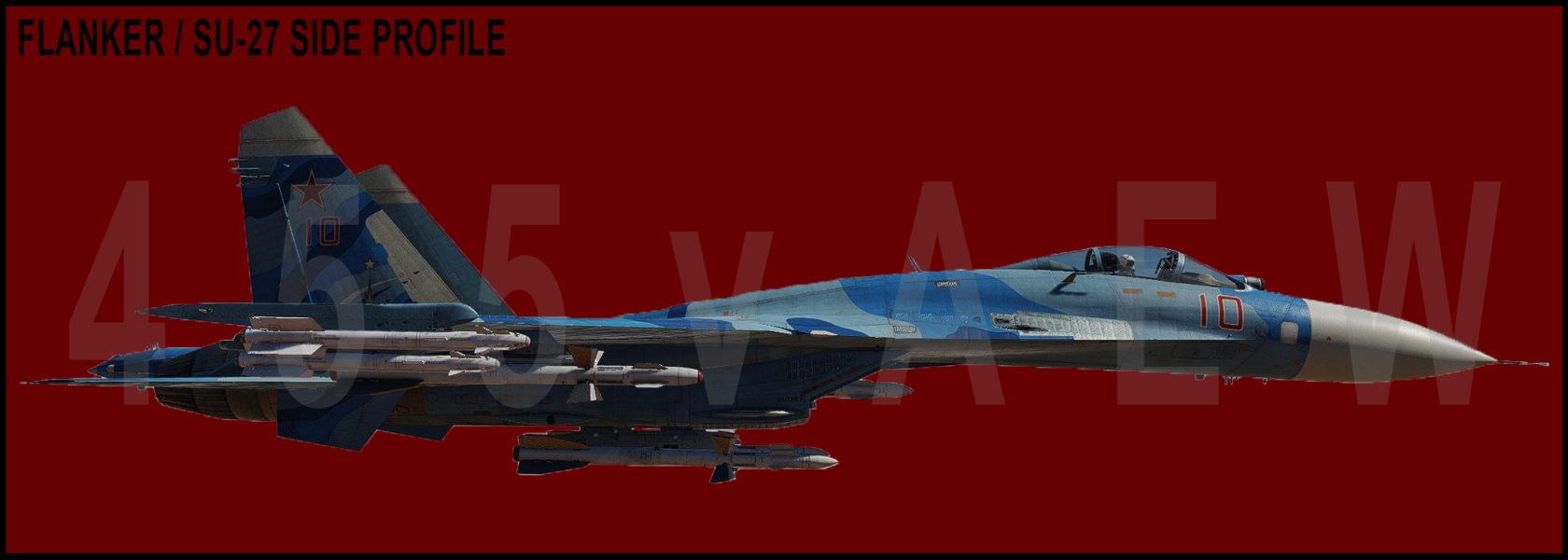FLANKER / SU-27
FLANKER / SU-27
The Su-27 is the Russian equivalent of the F-15E. Designed Designed primarily for the air superiority mission, the Flanker is adequately equipped with with up to 10 air-to-air missiles, and a very powerful radar. However, the Su-27 does does have A/G in addition to A/A capability.
The wings are mid-mounted and semi delta with square tips. The LERX extends downward and forward of the wing
roots. There are two turbojet engines in the fuselage. There are square, diagonally cut air intakes mounted under the wings alongside the fuselage. The fuselage is is rectangular from the air intakes to the tail. The nose is pointed and there is a
bubble canopy. The tail fins are swept-back, tapered with square tips, and and mounted outboard of the engines. The flats are mid-mounted, swept-back, and and tapered.
Variants
- SU-27 FLANKER Initial production version; (Equivalent threat is modeled in DCS.)
Airframe
- Length -72'
- Wingspan – 48'”
- Height – 19'
- Wing Area –
- Empty Weight –
- Combat Weight –
- Max Takeoff Weight – 66135 lbs
- Wing Loading –
- Power Plant
- 2× AL31F Lyulka turbofans
- 27557 lb wet thrust
- 17857 lb dry thrust
- Engine Smoke: TBD
- Cockpit Visibility: Fair
- AAR Capabilities: Drogue
Aerodynamic Handling
Turn / Dogfight Capabilities
- Instantaneous Turn –
- Sustained Turn –
- Max AOA –
- Max-G - 9 Gs clean
- Vertical - Very High
- Horizontal - Very High
- Trust Rate Ratio:
Combat Radius
- Combat Radius - 810nm
- Ferry Radius - 2160nm
Avionics Avionics
Radar
The onboard NIIP N001 Myech (“Slotback”) radar has has ample power compared to the MiG-29 N-019E, and is capable of detecting the F-16 out to 48nm. or more.
However, the powerful radar and the wide azimuth gimbal limit limit exceeding 70° gives the airplane a tremendous amount of target search abilities, and this airplane, unlike traditional Russian fighters, is capable of autonomous autonomous operations, independent of GCI control.
Search / Track Ranges / Burnthrough Ranges
In terms of raw power, this radar will burn through through self protection jammers at ranges exceeding 22nm., allowing the Su-27 to to take BVR shots beyond most AIM-120 engagement ranges. Look up range – 133 NM, look down – 88 NM, burn
trough range – 22 NM.
IRST Capabilities
A passive IRST is installed that is is capable of detecting MIL power targets out to about 12nm. in the rear quarter.
Defensive RWR RWR
The RWR performance is similar to that of the MiG-29, i.e. being able to detect the APG-68 transmissions up to 23 –25nm.
away.
AAI/IFF
The onboard self defensive equipment include include CMDS, SPO-15 RWR, and the airplane can be equipped with wingtip mounted
Sorbtsiya self protection ECM pods. This gives the Su-27 a formidable amount of of self defense capabilities, equivalent to most Western fighters.
Expected Contact Ranges
- APY-1/2: 270-210nm
- Target RCS 5m2
| Ownship Aircraft |
Range |
Range |
MiG-29 Range |
| F-15 | 58.5nm | 36.3nm | 33.8nm |
| F-16 | 38.4nm | 23.0nm | 24.2nm |
RWR Indications
[Insert Image]
The RWR signature of the N001 radar is also very very similar to that of the N-019E Slotback on the MiG-29A and N-019ME
Topaz on the MiG-29C, making it impossible to distinguish either of the the three.
Air to Air Armament
| Aircraft | IR WVR Missiles |
WVR Semi- Radar |
IR BVR Missiles |
Semi-Active Radar (BVR) |
Active Radar (BVR) |
| SU-27 | AA-11 | X | AA-10 | AA-10 | AA-12 |
Radar Missile / IRH BVR Missile
- SU-30
- up to 6 x R-77 (AA-12 ADDAR)
- up to 2 x R-27 (AA-10A ALAMO-A) / (AA-10B ALAMO-B) / (AA-10C ALAMO-C) / (AA-10D ALAMO-D)
- SU-27
- up to 4 x R-27 (AA-10A ALAMO-A)
- up to 2 x R-27 (AA-10A ALAMO-A) / (AA-10B ALAMO-B) / (AA-10C ALAMO-C) / (AA-10D ALAMO-D)
- up to 4 x R-27 (AA-10A ALAMO-A)
Heat Missile
- up to 6 x R-73E (AA-11 ARCHER)
Gun System
- 1 x 30-mm Gsh 30-1 w. 150 rounds.
- There is a WARNING in the Su-27[SK] Flight Manual requiring a 3-minute break during gun employment after every 50 fired rounds for heat resistance and life extension.
Offensive Strike Capabilities
Able to carry FAB-250 bombs, KMGU-2 submunitions dispensers, 3B-500 napalm tanks, and 80 mm, 130 mm mm and 240 mm rockets in ground attack role.
Defensive Systems
Three banks of APP-50 chaff/flare dispensers, with a total of 96 cartridges, in bottom of the long tailcone and top of the tailsting. Tailcone widened to provide additional chaff/flare dispensers from batch 18.
- Chaff – 30 x 26mm Chaff cartridges
- Flare – 30 x 26mm Flare cartridges
Strengths and Weaknesses
The threat posed by the Su-27 is primarily BVR. The The N001 radar is hardened against ECM and countermeasures, making chaff less
useful. Together with the long range AA-10C, this allows the Su-27 to strike at at ranges beyond most other Western airplanes.
With 10 air-to-air missiles, the combat persistence of the the Su-27 exceeds most Western fighters. Even when fired at the radar burnthrough burnthrough range of 22nm., the AA-10C will be closer to its Rmax2 range range compared to other Western missiles. This means that the missiles will arrive at at the target with a very high energy state.
The huge acceleration capability of the Su-27 also confers confers it an F-pole and A-pole advantage over most other fighters. The Su-27 is also also capable of A-pole tactics, with the ability to carry up to six AA-12 missiles. This gives it even better combat persistence than the F-15C.
When detecting an RWR contact, due to the similar radar radar characteristics between the Su-27’s N001 radar and the MiG-29’s N-019 radar, you can never tell which aircraft has locked you up.
If you lock up the threat and it employs ECM, you can be be reasonably sure that it is either a Russian MiG-29C or a PRC or Russian Su-27. As such, treat the contact as a Su-27 until you can verify otherwise. If you you want to close in for an engagement, bear in mind that you may be be unknowingly flying yourself into AA-12 envelope.
At WVR ranges, fighting the Su-27 will be similar to to fighting the F-15C. The aircraft has tremendous ability to accelerate at lower
weights. The Su-27 will be operating at heavier weights during most most encounters, making considerably less agile than what most aerospace aerospace observers are used to seeing at air shows. However, the missile complement of of up to four AA-11 makes fighting the Su-27 an even more nerve wrecking wrecking experience at close quarters compared to the F-14 or F-15.
This aircraft is often employed in conjunction with the A-50 50 MAINSTAY aircraft.
The slow speed handling characteristics of the airplane are are excellent, with good nose pointing capabilities. However, due to the heavy heavy operating weight, the F-16 driver may be able to bring the nose around to the Su-27 slightly faster and out-turn the Su-27, though the HMS/AA-11 advantage will will redress this disadvantage somewhat. When encountering the Su-27 at close
quarters, make sure that you stay out of the cone extending from its 10 o’clock clock position to its 2 o’clock position, as this is the AA-11 launch envelope. As with with the MiG-29, proper throttle management and IRCM tactics will help you stay out out of trouble (hopefully) by denying an IR missile lock.
Countertactics
If If you are tasked with DCA or BARCAP, you will need to place your CAP route route sufficiently far away from the ground assets that you are defending, as the Su-27 is capable of long range stand-off attacks. If your CAP route is too close to the ground asset that you are defending, the Su-27 will be able to strike it just when you are intercepting it.
- Alamo Shot / Radar – Beam with Chaff
- Addar Shot / Radar - High speed dive to low alt
inin opposite direction with chaff and “S” turns to kinematically defeat the missile. - Archer Shot / Radar - Throttle to idle w/flares and beam, avoid 120 deg arc in front of Flanker
- Turning Fight – Stay at Corner Velocity – 350-450 KIAS
Recent exploitations of the Russian employment of the SU-27 in BVR have shown a tendency for pilots to shoot 1 SARH (AA-10A/AA-10C) and 1 SAIRH (AA-10B/AA-10D) in a given volley. Given this Launch and decide tactics are discouraged unless required by ALRs. If LD tactics are to be used, a heathy amount of countermeasures, and retarding the throttle to MIL in the notch will help to defeat the IR ALAMO threat.
FLANKER Counter Threat Timeline
Refer to 455vAEWTTP 3-1.F-16 Attachment 2 2
Threat Replication Guidance
Refer to 455vAEW / 18th vAGRS vAGRS


